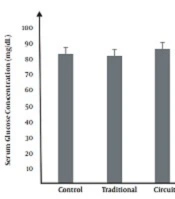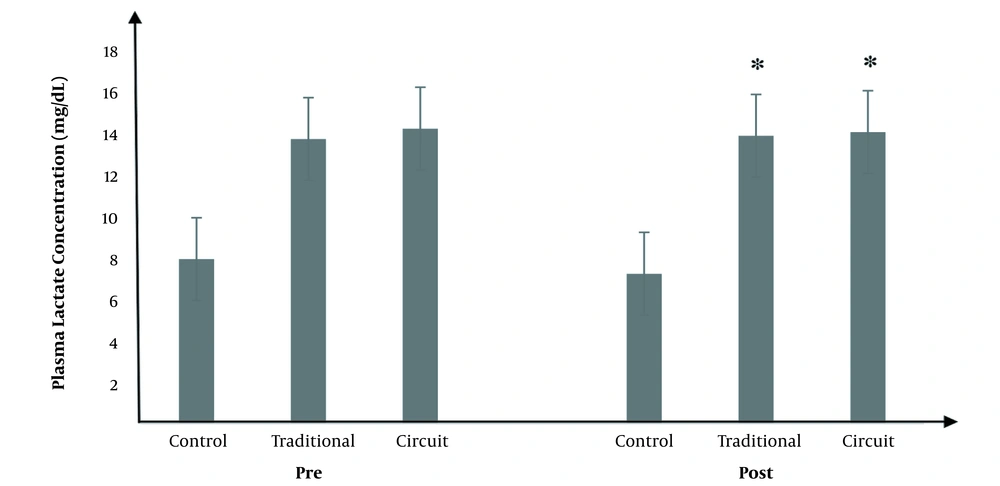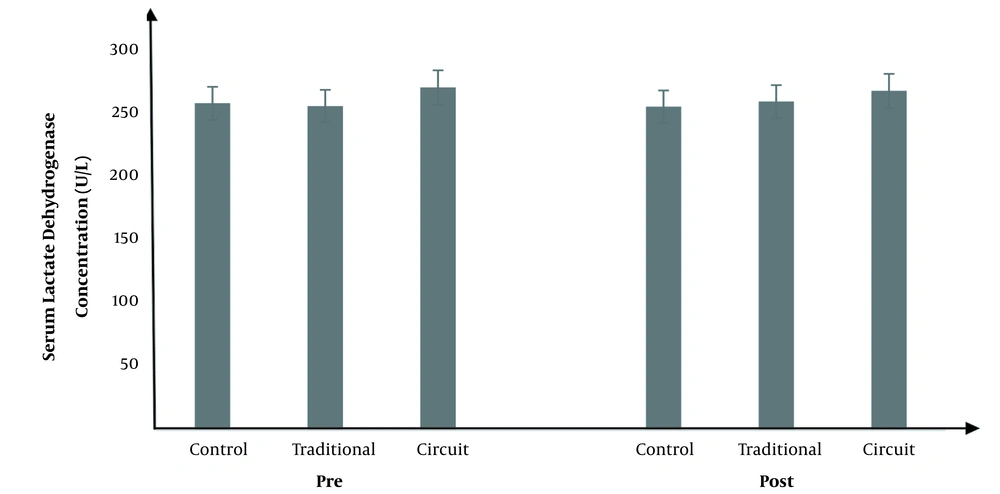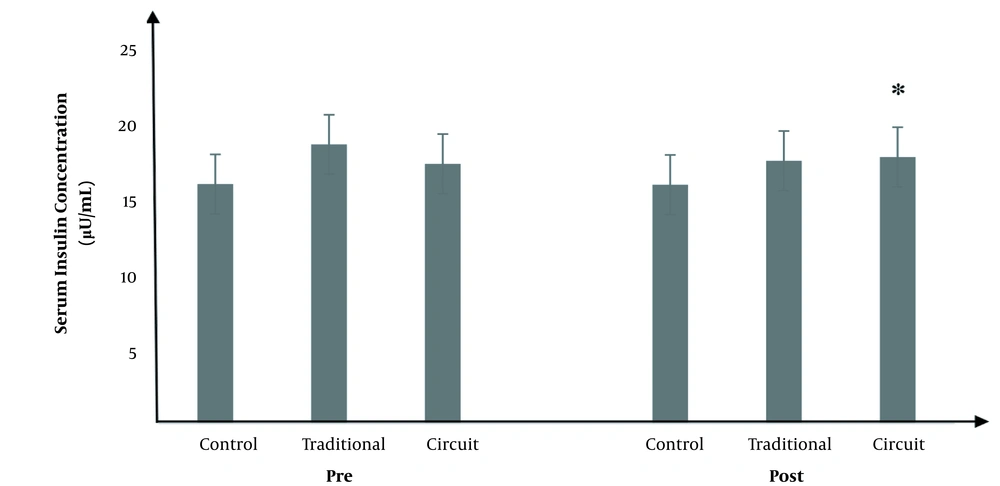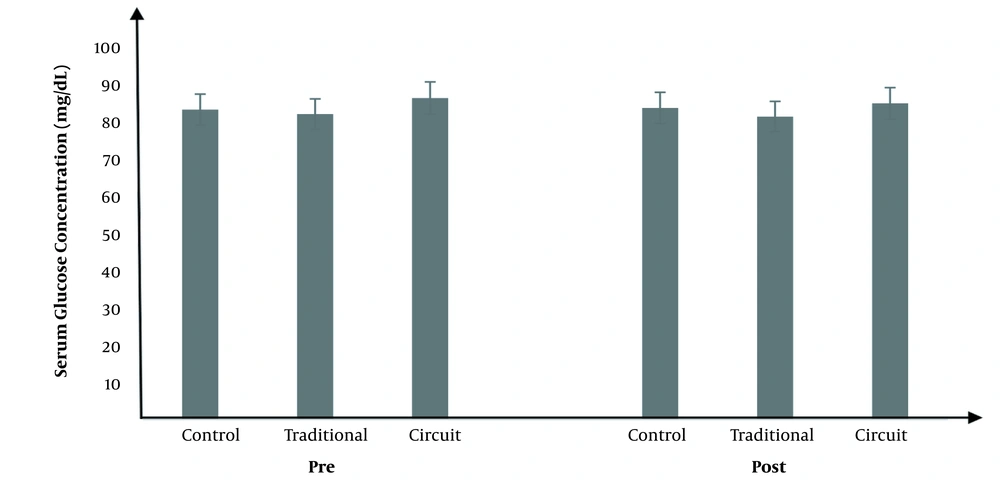1. Background
Wrestling is a tough and intense physical activity that, in addition to mental and psychological preparation, requires a level of high physical fitness (1, 2). Wrestling can be considered an intense intermittent activity that requires high aerobic and anaerobic fitness (1, 3). In wrestling, like many other sports (such as taekwondo and kickboxing), aerobic and anaerobic energy systems are used to varying degrees. Anaerobic metabolism is used prominently during combat, and aerobic metabolism is used to maintain activity during recovery periods (4, 5). Exercise intensity in a wrestling match is 95 to 100% of the maximum oxygen consumption (2, 6). Intense explosive movements and repetitive struggles in wrestling with maximum and super-maximum intensity require the athlete to have a high level of physical fitness (1, 5).
Concentrations of lactate, lactate dehydrogenase (LDH), glucose, and insulin are important physiological variables associated with physical fitness and fatigue (7), and the type of exercise may affect these factors differently. However, all 3 energy systems are involved in wrestling competitions and training. It is estimated that 90% of energy production is provided by the phosphagen and lactic acid system, and the remaining 10% is produced through the aerobic system (1, 2). It is reported that the percentage of involvement of different energy production systems in wrestling is such that the non-lactic anaerobic system has a 30% share, the anaerobic lactic system has a 30% share, and the aerobic system has a 40% share of energy production (8).
Another study showed that the major energy required in wrestling is produced through anaerobic glycolysis, which eventually produces lactate (9, 10). The examination of the intensity of wrestling shows that the anaerobic component is essential in wrestling. In fact, the concentration of blood lactate in wrestlers is considered an indicator of anaerobic capacity for success in wrestling (1). In anaerobic exercise, increased lactate levels due to decreased blood flow result from isometric contractions in active muscles following intense exercise (11). Reduction of blood flow to the liver, which reduces the Cori cycle, is also one of the causes of elevated blood lactate (12).
Intracellular acidosis due to increased lactic acid is an important factor in causing fatigue (13). In general, during contraction, muscles produce lactic acid in the absence of oxygen. Decreased lactate accumulation improves the performance of anaerobic endurance during exercise (14). LDH is an enzyme that mediates the production of lactic acid from pyruvate (15). Lactic acid production and athletes’ physical tolerance to lactate play an important role in causing fatigue and decreased performance (16). Low LDH indicates less lactic acid production, and lower lactate indicates less acidosis (17). Glucose is the body’s predominant fuel in strenuous short-term intense activities (such as wrestling) and is transported to tissues by insulin.
It has been shown that regularly performed strenuous activities can affect athletes’ lactate, LDH, glucose, and insulin levels, and there is a difference between the effects of various exercises on these variables (18, 19). As mentioned above, the changes in these variables are related to the physical fitness and performance of athletes.
2. Objectives
The present study compared the effects of 6 weeks of traditional and circular wrestling training on blood concentrations of lactate, LDH, glucose, and insulin in young male wrestlers.
3. Methods
3.1. Research Design
The present study is a field and quasi-experimental study, accompanied by the implementation of instruction. The Ethics Committee of Mazandaran University approved this study (code: IR.UMZ.REC.1400.043).
A total of 27 athletes from a gym in Amol City participated in this study, signed written consent forms, and were informed about the research conditions. The inclusion criteria were being male, young, and wrestler, as well as having an average of 3 to 5 exercise sessions per week. The exclusion criteria were taking drugs and supplements in the last 6 months, poor health and illness, and having surgery in the last 6 months. The subjects were randomly divided into 3 groups (ie, traditional wrestling training, circular wrestling training, and control groups) and performed interventions based on the group name for 6 weeks. Blood samples were taken from all subjects 48 hours before and 48 hours after the interventions, and samples were sent to a laboratory for analysis (20).
3.2. Study Interventions
(1) The control group consisted of wrestlers who withdrew from wrestling training for at least 6 - 24 months and were not engaged in any other regular or irregular sports activities. This group did not exercise and only participated in the pre-and posttest.
(2) The traditional wrestling group consisted of 9 subjects who practiced traditional wrestling. The traditional wrestling group performed their usual exercises similar to the circular training group in terms of training time. The exercise protocols of the traditional training group included usual 48-minute wrestling exercises similar to the circular training group. This exercise protocol was performed in 2, 3, and 4 minutes consisted of commonly used exercises with an intensity close to the competition, including 12 minutes of warm-up + 48 minutes of exercise + 15 minutes of cooling; rest between exercises was also proportional to the time of activity.
(3) The circular training group (9 subjects) included young male wrestlers. The exercise protocol of this group included circuit training based on wrestling techniques, such as standing techniques and some on the ground, which were performed in 6, 8, 12, and 16 stations and 6 to 7 turns. There was a 3-minute rest between each turn. Table 1 shows exactly how to perform the exercise.
| Week | Warm-up (min) | Number of Round | Number of Station | Station Time (s) | Total Time of Each Round (min) | Cooldown (min) |
|---|---|---|---|---|---|---|
| First | 12 | 6 | 6 | 45 | 7.30 | 15 |
| Second | 12 | 7 | 8 | 30 | 7 | 15 |
| Third and fourth | 12 | 6 | 12 | 25 | 8 | 15 |
| Fifth and sixth | 12 | 6 | 16 | 20 | 8.20 | 15 |
Circuit Training Protocol
3.3. Method of Measuring Variables
Serum glucose and LDH were measured biochemically by Bionics’ commercial kits. Lactate was also measured in blood plasma by biochemical methods using a Hitachi Auto Analyzer (7180, Series 2018, Japan) and was tested with a commercial kit (Pars Azmoun Company, Iran). Serum insulin was measured by enzyme-linked immunosorbent assay (ELISA), and Monobind kits were measured according to the kit instructions of Dr Ghahari’s Babolsar Laboratory with a Biohit ELISA reader.
3.4. Statistical Method
Data obtained from the subjects were reported as mean and SD in the figures. The Shapiro-Wilk test was used to determine the natural distribution of data. Since the values of the studied outcomes in the pre-and posttest were measured from 3 groups, multivariate analysis of covariance (MANCOVA) was used to determine the net effect of the presented interventions (21). This test inhibits the effect of a pretest for posttest values and is the most appropriate statistical model for designs with a pretest (22). If a significant difference was observed between the groups, the Ben Foroni follow-up test was used to determine the source of the difference. To determine the effect of interventions’ power on the outcomes of studied cases, the effect size was calculated. P-values less than 0.05 were considered statistically significant for all calculations. The calculations were performed using SPSS version 21 (SPSS Inc, Chicago, Ill, USA).
4. Results
The results of the present study showed a significant difference between the groups in plasma lactate concentration (P = 0.013, F = 5.309, and ES = 0.316). Traditional (P = 0.01) and circuit exercise trainings (P = 0.03) significantly increased plasma lactate concentration. There is no significant difference between the effects of 2 types of training on blood lactate concentration (P = 0.99; Figure 1).
The results of the present study showed that there was no significant difference in serum LDH concentration between the groups (P = 0.397, F = 0.962, and ES = 0.077; Figure 2).
The results of the present study showed a significant difference in serum insulin concentration between the groups (P = 0.005, F = 6.594, and ES = 0.364). Circuit training (P = 0.004) significantly increased serum insulin concentration. Traditional training had no significant effect on serum insulin concentration (P = 0.91; Figure 3).
The results of the present study showed no significant difference in serum glucose concentration between the groups (P = 0.752, F = 0.288, and ES = 0.024; Figure 4).
5. Discussion
In general, the results of the present study showed that traditional training significantly increased the plasma lactate concentration of wrestlers and had no significant effect on their serum LDH, insulin, and glucose concentrations. Circuit training significantly increased plasma lactate and insulin concentrations and had no significant effect on serum LDH and glucose concentrations. There was no significant difference between the effect of traditional and circuit training on plasma lactate concentration. The results of a meta-analysis (23) showed that intense exercise close to the lactate threshold or ventilation was a good stimulus to improve the threshold for sedentary people, and lack of exercise (detraining) reduced the lactate threshold and ventilation.
In the present study, lactate concentration increased after exercise, and it is important to note that the lactate threshold may also have increased. One of the limitations of our study is the lack of measurement of ventilation/lactate threshold by a gas analyzer (23). Since athletes in the present study performed intense training, the growth of type II muscle fibers can also be a factor in increasing serum lactate due to its high glycolytic capacity, mitochondria, and lower aerobic capacity (24).
LDH is an enzyme that enters the bloodstream from muscles when injured (24). Therefore, no changes in LDH can be a good sign that both traditional and circuit training are suitable for wrestling. This enzyme also mediates the reaction of pyruvate to lactic acid (25). The results of the present study showed an increase in lactate and no increase in LDH enzyme after wrestling training. As a mechanism, it may be stored in cell vesicles (when blood lactate reaches more than 20 mmol). This cellular storage of lactate increases lactate concentration in the blood at rest and after exercise (26).
It has been shown that 16 weeks of resistance training with an intensity of 80% 1RM increases insulin function by 43% in men with type 2 diabetes (27). Consistent with the present study, an increase in insulin and no changes in blood glucose as a result of interval training and also an increase in lactate as a result of bodyweight circuit training were observed. High-intensity training increase glucose uptake and depletion of liver glycogen (27, 28).
Since serum glucose did not change significantly in the present study and the amount of insulin increased, it seems that the liver glycogen stores were not depleted and regulated blood glucose at the level of homeostasis. In the present study, a beneficial effect was seen after circuit training, and traditional training did not have this effect.
5.1. Conclusions
The results of the present study showed that these 2 types of training have a similar effect on the measured variables, but it seems that circuit training has a more profound effect on the measured variables than traditional training, which can probably be attributed to the greater use of resources and lactic energy apparatus in circuit training, which in turn can be superior in the preparation of wrestlers for traditional training. However, further studies are needed to prove these results.
